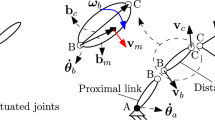Abstract
In the previous study, the minimum time and energy have been both considered to improve the efficiency and reliability of the manipulator operations. For further guaranteeing the tracking precision of end effector, a TE-E optimal planning technique is presented in this paper to optimize the trajectory of end effector. TE-E means two optimization objectives and one constraint condition: T is the total motion time, the first E is the total kinetic energy consumption and the second E is the motion error due to trajectory planning. In this technique, a local optimization process is completed to find a time-energy optimal trajectory, which could improve the movement efficiency and reliability. In this local process, the screw theory is used to obtain the forward and inverse kinematic models for simplifying the computation. The multi-solution situation in inverse kinematic is considered. The modified cubic spline interpolation is applied in the joint space to obtain the good motion stability. The objective function is defined as the weighted sum of two optimization objectives. The local optimal trajectory is obtained by using the particle swarm optimization (PSO) algorithm. Finally, the motion errors are considered as a condition to determine the number of the path points and obtain the final optimal trajectory that has good tracking precision. The simulation experiment for QJ-1 welding manipulator is completed to verify the reliability and validity of this technique. In the optimal trajectory, the relationships between the motion time and parameters for each joint show a good performance in the motion. The comparison of motion errors obtained by using the previous and presented methods proves the validity of this presented technique.
Similar content being viewed by others
References
Xiong, Y.K.: Trajectory Planning and Control Implementation for 3-DOF Parallel Robot [D]. Dalian University of Technology, China (2014)
Mavroidis, C., Lee, E., Alam, M.: A new polynomial solution to the geometric design problem of spatial RR robot manipulators using the denavit and hartenberg Parameters[J]. J. Mech. Des. 123(1), 58–67 (2001)
Karlik, B., Aydin, S.: An improved approach to the solution of inverse kinematics problems for robot manipulators[J]. Eng. Appl. Artif. Intell. 13(2), 159–164 (2000)
Zhao, X.H., Peng, S.X.: Research on the singular configuration of parallel manipulators[J]. Chinese J Mech. Eng. 36(5), 35–37 (2000)
Nakamura, Y, Hanafusa, H.: Inverse kinematic solutions with singularity robustness for robot manipulator control[J]. J. Dyn. Syst. Meas. Control. 108(3), 163–171 (1986)
Tchon, K., Muszynski, R.: Singular inverse kinematic problem for robotic manipulators: a normal form approach[J]. IEEE Trans. Robot. Autom. 14(1), 93–104 (1998)
Klein, C.A., Chu-Jenq, C., Ahmed, S.: A new formulation of the extended Jacobian method and its use in mapping algorithmic singularities for kinematically redundant manipulators[J]. IEEE Trans. Robot. Autom. 11(1), 50–55 (1995)
Selig, J.M.: Geometric Fundamentals of Robotics[M]. Springer Science & Business Media, New York (2004)
Park, F.C., Bobrow, J.E., Ploen, S.R.: A lie group formulation of robot dynamics[J]. Int. J. Robot. Res. 14(6), 609–618 (1995)
Rocha, C.R., Tonetto, C.P., Dias, A.: A comparison between the Denavit–Hartenberg and the screw-based methods used in kinematic modeling of robot manipulators[J]. Robot. Comput. Integr. Manuf. 27(4), 723–728 (2011)
Sariyildiz, E., Cakiray, E., Temeltas, H.: A comparative study of three inverse kinematic methods of serial industrial robot manipulators in the screw theory framework[J]. Int. J. Adv. Robot. Syst. 8(5), 9–24 (2011)
Zhao, J., Liu, Y., Cai, H.: Solution for one type of inverse kinematics sub-problem in screw theory and its application [J]. Robot 27(2), 163–167 (2005)
Wang, Z.C., Li, Y.Q.: Inverse dynamics modeling and emulating of flexible Multi-Arthrosis manipulator based on screw theory[J]. J. Jilin University (Science Edition) 49(1), 98–104 (2011)
Wang, K., Diao, C.: SCARA Robot dynamics analysis based on screw theory[J]. Mech. Eng. 3, 009 (2010)
Zhao, G., Wang, H., Liu, Y.: Research on configuration and kinematics of joint modular robots[J]. Mach. Design Manuf. 4, 178–180 (2010)
Piazzi, A., Visioli, A.: Global minimum-time trajectory planning of mechanical manipulators using interval analysis[J]. Int. J. Control 71(4), 631–652 (1998)
Gasparetto, A., Zanotto, V.: Optimal trajectory planning for industrial robots[J]. Adv. Eng. Softw. 41(4), 548–556 (2010)
Gregory, J., Olivares, A., Staffetti, E.: Energy-optimal trajectory planning for robot manipulators with holonomic constraints[J]. Syst. Control Lett. 61(2), 279–291 (2012)
Wang, H.F.: Research on multi-objective trajectory optimization and motion control for serial robot manipulators [D]. Zhejiang University, China (2011)
Liu, H., Lai, X., Wu, W.: Time-optimal and jerk-continuous trajectory planning for robot manipulators with kinematic constraints[J]. Robot. Comput. Integr. Manuf. 29(2), 309–317 (2013)
Pajak, G., Pajak, I.: Point-to-point collision-Free trajectory planning for mobile manipulators[J]. J. Intell. Robot. Syst., 1–16 (2016)
Zhang, X.J., Gao, X.H.: The research on cubic splines in robot’s trajectory planning [J]. Mach. Design Manuf. 9(2), 170–171 (2008)
Sariyildiz, E., Temeltaş, H.: A new formulation method for solving kinematic problems of multiarm robot systems using quaternion algebra in the screw theory framework[J]. Turkish J. Electr. Eng. Comput. Sci. 20(4), 607–628 (2012)
Poli, R., Kennedy, J., Blackwell, T.: Particle swarm optimization[J]. Swarm Intell. 1(1), 33–57 (2007)
Liu, H., Lai, X., Wu, W.: Time-optimal and jerk-continuous trajectory planning for robot manipulators with kinematic constraints[J]. Robot. Comput. Integr. Manuf. 29(2), 309–317 (2013)
Acknowledgements
The research is supported by Beijing Municipal Science & Technology Commission (Name: The key technologies of harmonic reducer for robotic joint and its typical applications), Large scientific research promotion program of Beijing University of Technology Jing-Hua Talents Project of Beijing University of Technology and National Natural Science Foundation (No. 51575009).
Author information
Authors and Affiliations
Corresponding author
Rights and permissions
About this article
Cite this article
Liu, Z., Xu, J., Yang, C. et al. A TE-E Optimal Planning Technique Based on Screw Theory for Robot Trajectory in Workspace. J Intell Robot Syst 91, 363–375 (2018). https://doi.org/10.1007/s10846-017-0706-3
Received:
Accepted:
Published:
Issue Date:
DOI: https://doi.org/10.1007/s10846-017-0706-3




